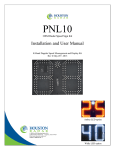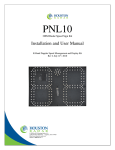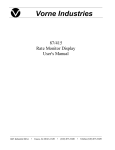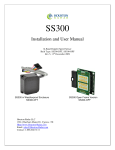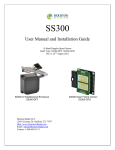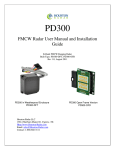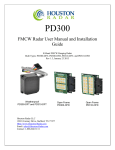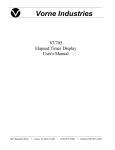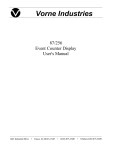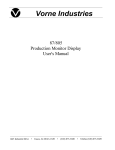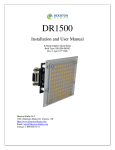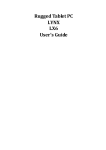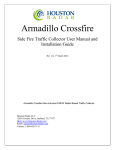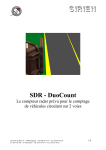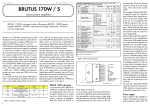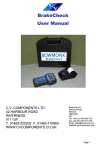Download “SLOW DOWN” - Houston Radar
Transcript
“SLOW DOWN” OEM Radar Speed Sign Kit Installation and User Manual K-Band Doppler Speed Measurement and Message Display Kit Rev 1 September 14th, 2011 Amber LED option Please inquire for other color options. Houston Radar “SLOW DOWN” sign User Manual The Doppler radar module incorporated in this device complies with part 15 of the FCC Rules. Operation is subject to the following two conditions: (1) this device may not cause harmful interference, and (2) this device must accept any interference received, including interference that may cause undesired operation. Changes or modifications not expressly approved by the party responsible for compliance could void the user's authority to operate the equipment. Any modification or use other than specified in this manual will strictly void the certification to operate the device. The radar in this device carries FCC modular approval and as such is labeled with FCC ID TIASS300. If this label is not visible when the module is installed inside another device, then the outside of the device into which the module is installed must also display a label referring to the enclosed SS300 module. This exterior label can use wording such as the following: “Contains Transmitter Module FCC ID: TIASS300” or “Contains FCC ID: TIASS300.” Any similar wording that expresses the same meaning may be used. Warning: The “SLOW DOWN” kit is supplied in an open frame format with exposed electronics and thus is a static sensitive device. Please use static precautions when handling. Warranty does not cover damage caused by inadequate ESD procedures and practices. Note: Specifications may change without notice. Note: Not liable for typographical errors or omissions. Page 2 of 21 Houston Radar “SLOW DOWN” sign User Manual Table Of Contents INTRODUCTION .........................................................................................................4 INSTALLATION ..........................................................................................................5 DIRECTION POINTING: ................................................................................................5 RECOMMENDED ENCLOSURE FOR THE “SLOW DOWN” SIGN:......................................5 HOOKUP:.....................................................................................................................7 Power Input:............................................................................................................7 Data/PC Connection: ..............................................................................................7 Measured Speed Output:..........................................................................................7 IO CONNECTOR SIGNAL DESCRIPTIONS: .......................................................................8 USE ................................................................................................................................9 COLLECTING AND ANALYZING IN-RADAR TRAFFIC STATISTICS............10 REAL TIME TRAFFIC STATISTICS IN THE RADAR:........................................10 Internal Clock:......................................................................................................10 CONFIGURING THE “SLOW DOWN” SIGN: .......................................................11 Rotary Switch Configuration ................................................................................12 Additional Configuration Options ........................................................................13 “SLOW DOWN” SIGN SPECIFICATIONS .............................................................15 GENERAL ...................................................................................................................15 APPROVALS................................................................................................................15 DATA INTERFACES .....................................................................................................15 OPTICAL ....................................................................................................................15 MECHANICAL .............................................................................................................15 PERFORMANCE ...........................................................................................................16 MECHANICAL OUTLINE DIMENSIONS:.............................................................17 APPENDIX A: KEEPING TIME WITH AN EXTERNAL CLOCK BACKUP BATTERY ...................................................................................................................18 Page 3 of 21 Houston Radar “SLOW DOWN” sign User Manual INTRODUCTION Congratulations on your purchase of the Houston Radar directional Doppler radar “SLOW DOWN” message sign kit. This state of the art speed triggered “SLOW DOWN” message display with integrated ultra-low power 24GHz K-band microwave Doppler radar is specifically designed for the license free solar power or battery operated traffic calming sign market. It may also be operated off AC mains by using a simple and inexpensive off-the-shelf AC to DC converter. Utilizing high performance, ultra low power DSP (Digital Signal Processing) technology and microwave components based on a planar patch array antenna with integrated low power PHEMT oscillator, you will find that this high quality product meets your exacting standards for performance and reliability. Some of the highlights of this product include: Zero cables highly integrated design assembles into your enclosure in minutes 9.5” (24cm) message height is matched to 300+ ft (90+ m) detection range of the radar for optimal display legibility Best in class power efficiency achieved by: • Low power SS300 radar directly drives display thus eliminating display controller • Built-in ambient light sensing and automatic brightness control When no traffic is present, the radar automatically powers down display further reducing power consumption to only 0.1W Wide input supply voltage operation allows flexible power supply options ranging from 3, 4 or 5 cell Lithium Ion packs to 12V Lead Acid batteries Built-in rotary switch allows user to set cutoff and violator speed alerts in the field without connecting to a computer Built-in radar is FCC approved with CE mark and available in 24.125GHz and 24.200GHz versions for worldwide deployment Advanced In-Radar Traffic Statistics collection option now available The “SLOW DOWN” message board is also available without the in-built Doppler radar. In this configuration it may be triggered as a slave by our PNL10 speed display kit above a pre-determined speed threshold. This makes for a very inexpensive option to add a “SLOW DOWN” message to the PNL10 and further enhance the value of the PNL10. See Appendix B for details. Page 4 of 21 INSTALLATION “SLOW DOWN” sign is supplied in an “open frame” format. It requires a weatherproof enclosure before it may be operated outdoors. Direction Pointing: The SS00 radar used in the “SLOW DOWN” sign is directional in nature. It may be configured to detect and measure the speed of incoming or outgoing traffic. It then rejects traffic moving in the opposite direction. Direction of detection is configured via a bit in the MO variable in the radar (or via the supplied Windows configuration program). In the usual “traffic calming sign” configuration the radar is set to measure and trigger the message off the speeds of incoming vehicles and is the default shipped from the factory. To achieve optimal performance please follow a few simple rules: Sign should be pointed into the direction of oncoming traffic. Sign should be placed along the size of the road to minimize the angle of the oncoming traffic to the sign. o If it cannot be placed right along the side of the road, it should be pointed at least 100-150 feet up the road into oncoming traffic. The radar in the unit may pickup rotating fans, compressor blades, etc. Avoid pointing it at any machinery containing moving parts. Sign should be mounted at least 3 feet high from the ground for proper operation and at least 5 feet high for maximum pickup distance Sign utilizes 15° viewing angle LEDs. For maximum visibility of the digits the sign should be pointed at the incoming traffic with better than 10° accuracy. Alternatively, the sign may be oriented towards traffic to maximize the LED brightness from the desired viewing location on the road. We suggest providing an adjustable mounting bracket for your enclosure that will allow at least a ±15° horizontal rotation to allow the user to make an adjustment during installation. Recommended Enclosure for the “SLOW DOWN” sign: The “SLOW DOWN” sign display kit must be protected by a weatherproof enclosure for outside use. The following needs to be observed for optimal performance: 1. Any plastic cover or window in front of the unit may be mounted as close to the LEDs as desired. However, please consider any potential damage from flexing due to an external impact on the sign face (vandalism, etc.) being transferred to the “SLOW DOWN” sign. For maximum field reliability we recommend that you Houston Radar “SLOW DOWN” sign User Manual test the proposed enclosure design to ensure the front face does not flex sufficiently to transfer an impact to the “SLOW DOWN” sign. The “SLOW DOWN” sign provides a clear hole in the center to allow you to pass a bracing standoff through it to transfer any face impact to the back of the enclosure. Do not mount the “SLOW DOWN” sign using this center hole. The center standoff should be mounted from the rear of the enclosure and clear through the “SLOW DOWN” sign display PCB and stop at the front face. This will allow any front face impact force to transfer to the rear wall of the sign enclosure. 2. The optimum material for the front window/face is Lexan (Polycarbonate) plastic. 3. The optimum thickness of polycarbonate window/sign face is half wavelength at 24.125Ghz or about 3.5 to 3.7mm thick. a. Commonly available ¼” thick Lexan is not optimal and will reduce pickup range. 3/16” thick Lexan is a better choice if the recommended thickness is not available. For metric sizes, 4mm thick Lexan is a reasonably good choice. b. Frosted (anti-glare) plastic have been successfully used as well. It does not matter which side (into the sign or into the traffic) the frosting faces and is left to your discretion. 4. Other plastic materials may be used as a front window, but the optimum thickness will wary with the material’s dielectric constant. Please contact Houston Radar for details. 5. If you want to make a metal mask to hide the electronics on the “SLOW DOWN” sign PCB with holes for the LEDs to pass through, you must provide a plastic window for the radar microwave beam to pass through. Contact us for the exact location and size of this window. A dxf drawing to use as a template for the metal mask is available. Please contact Houston Radar for the drawing. We strongly recommend that you prototype and test your enclosure on the road to verify that the radar detection range is not affected by your choice of plastic and mechanical design prior committing to full production. Page 6 of 21 Houston Radar “SLOW DOWN” sign User Manual Hookup: Power Input: The “SLOW DOWN” sign may be powered from a DC supply with output voltage between 7.5 and 18VDC. This allows great flexibility in power options including 12V (nominal) lead acid batteries (SLA), 3, 4 or 5 cell Lithium Ion (LiOn) or Lithium Iron Phosphate (LiFePO4) cells. There is no other message sign in the world that even comes close to the resulting ultra-low power usage of the “SLOW DOWN” sign. Competing products may consume up to 5 to 10 times more power. This ultra low operational power translates directly into a longer battery life or gives you an option to power the unit from smaller batteries and smaller solar panels. A convenient battery life calculator is available on our website to estimate the run time under different traffic and power supply situations. Data/PC Connection: The “SLOW DOWN” sign features a standard RS232 interface that is used to configure the sign as explained later in this document. It also sends out the measured speed over this interface when a vehicle is detected which may be used by an external controller board to monitor the speed measured by the radar in the “SLOW DOWN” sign kit or display on a connect PC running our Stats Analyzer or Configuration software programs. Measured Speed Output: The “SLOW DOWN” sign will send out the speed via the ASCII interface as a 3-digit speed with an optional direction indicator in standard resolution mode. Extended resolution mode adds up to 3 digits after the decimal point. The format is: [?,+]nnn[\r,\n] or in extended resolution mode [?,+]nnn[.n[n[n]]][\r,\n] The format of the speed output can be adjusted to any combination of: “?”: Optional prefix sent when 000 selected to be sent when no vehicles are detected “+”: Optional prefix sent when nnn speed is sent for incoming vehicles “nnn”: Three digit ascii speed in the units selected via the UN variable “[.n[n[n]]]”: Optional decimal point with up to 3 digits of extended resolution selected via UN variable. “\r”: Carriage Return character, optional line ending “\n”: Line Feed character, optional line ending Please see serial port configuration section for details on how to select the above format. The radar used in the “SLOW DOWN” sign is the Houston Radar SS300. Please see the SS300 user manual for more details on setting the output format and decimal point options. Page 7 of 21 Houston Radar “SLOW DOWN” sign User Manual IO Connector Signal Descriptions: DB9 RS232 Female Connector: Connector Pin # 1 Signal Name +VCCNote 1 Direction Description PWR Note 1 Radar VCC (battery “+“ terminal) Note 1 2 RS232 TX OUT RS232 Serial port TX pin from sign 3 RS232 RX IN RS232 Serial port RX pin into sign 4 N/C - Do not connect 5 6 GND N/C PWR - Signal/PWR Ground Do not connect 7 N/C - Do not connect 8 N/C - Do not connect 9 N/C - Do not connect (wrt Radar) Note 1: Pin 1 optionally connected to +VCC (supply +) if PCB pad labeled “DB9 PWR” near DB9 connector is bridged. This may be bridged by the OEM or by us if you require this feature. This area left blank. Page 8 of 21 Houston Radar “SLOW DOWN” sign User Manual USE Turn on the power to the “SLOW DOWN” sign to make it operational. The message will illuminate for about 4 seconds and then blank out. The sign is now fully operational. If the rotary speed switch is enabled (see later section on configuration), turn the speed switch to the desired position (0 through 7) determined by the speed limits on the road to set the low-speed display cutoff, flashing speed and the high-speed display cutoff. Typically, users set the low speed cutoff and violator flashing speed at or just above the speed limit on the road. For example, for a 25mph speed limit road, the violator limit may be set to 26 mph. Since the sign does not display the vehicle speed, there is no chance of “racing against the radar by miscreants” and the high-speed cutoff may be set to the maximum value. The exact values are of course left to the judgment of the user. No other action is required. The “SLOW DOWN” sign will illuminate the message when an incoming vehicle is detected between the low-speed and high-speed limits. The display will blink at about 1.4Hz rate if the measured speed is above violator speed. This indicates to the driver that they are driving above the speed limit. As long as the radar is tracking a target between the low-speed cutoff and the high-speed cutoff, the radar will transmit the speed in user selected ASCII format over the serial interface. This may be observed via our PC based configuration tool or captured by an external user provided controller board. Monitoring or capturing this speed is not required for normal operation of the speed sign. Serial output is affected by low, high and violator speed configuration in the same way as the display. This area left blank. Page 9 of 21 Collecting and Analyzing In-Radar Traffic Statistics The “SLOW DOWN” sign supports optional “In-Radar” advanced traffic statistics collection. This feature is sold separately. If this feature is enabled you may collect the stored statistics by using the provided Houston Radar Advanced Statistics Analyzer Windows program. This program must be installed on a MS Windows 7, Windows 2000, XP or Vista PC (32 bit and 64 bit versions) and allows the retrieval of stored statistics from the radar by using a PC serial port. It also has features to generate traffic reports, plot interactive graphs and export the raw data to a MS Excel file. Please refer to the on line help functionality of the program after you install it on your computer for detailed instructions on how to use its functionality. Real Time Traffic Statistics In the Radar: The “SLOW DOWN” sign In-Radar stats software now features “real time” histogram statistics. These are updated as soon as a vehicle is detected and may be read out as a speed bin count “histogram”. Thus no historical records need be read out and parsed to read statistics. This feature requires a host program to be on-line to read the live statistics. Please contact Houston Radar for more information if you are interested in acquiring live statistics from the radar. Internal Clock: The “SLOW DOWN” sign has a built in clock/calendar function. This is used to keep the time to date/time stamp the historical archive records saved by the Advanced InRadar traffic statistics collection feature that is available as an option in the radar. The “SLOW DOWN” sign does not feature a clock backup battery. So power must remain connected to the radar for the clock to keep time. However an external clock battery may be connected to keep time while “SLOW DOWN” sign goes into low power sleep mode. See Appendix A for more details. Configuring the “SLOW DOWN” sign: The “SLOW DOWN” sign can easily be configured via a user-friendly MS Windows PC based graphical user interface (GUI) software that makes this configuration a snap for the end user. Step 1: Power up the sign and connect to the DB9 connector on the back of the unit via a PC COM (serial) port cable: Step 2: Launch the provided Houston Radar Configuration tool or Houston Radar Traffic Stats Analyzer MS Windows program. Click on File->Connect to Radar… and then click on “Connect” button. Once the radar is found, click the “Radar Configuration” tab and you should see this window. Pick your preferred units here. Speed is also sent in these units over the serial port. Message will flash above this speed. Message will be illuminated above this speed. Sets how far vehicles will be picked up relative to maximum range of radar. Rotary Switch Configuration To setup the rotary switch, first enable the rotary switch GUI as shown below: Enable the rotary switch GUI. On the “Hardware & IO Configuration tab”. You will then be able to setup the rotary switch settings via the new “Detection Limits Setup” tab that will be visible. Houston Radar “SLOW DOWN” sign User Manual The above partial window-capture shows the configuration for the rotary switch installed on the rear of the “SLOW DOWN” sign. This screen is only visible if the “Show Rotary Switch GUI” checkbox is checked in “Hardware & IO Config” tab. You have three different options: 1. Rotary switch changes only the low limit: Enable the rotary switch and have it select the low-speed, speed limit and highspeed limits in the sign (a blue line will be drawn from the “test rotary switch position” to below the low limit and high limit sliders to remind you that they are linked to the rotary switch). 2. Rotary switch changes all three limits: Enable the rotary switch and have it only select the low-speed cutoff. The speed limit and high-speed limits are then fixed and can be changed via the slider (the blue line from the “test rotary switch position, speed increment to the bottom of the LO limit slider is a visual reminder that the low limit is linked to the rotary switch). 3. Manually set all three limits to fixed values: Disable the rotary switch completely and manually supply fixed values for all three limits. This option is for fixed installations where the sign will be mounted permanently in one location and you know what limits will be required for that location. You can easily test your settings by clicking the “Check Limits” button and then spinning the “Test Rotary Switch Position” up/down. This will adjust the slider and show you the effective limits for each position. Alternatively you can view and print the entire table for all switch positions by clicking on the “Display Speed Limits Button” button. Please note that spinning this “virtual” rotary switch does not affect the actual sign. To change the speed limits in the sign, the actual rotary switch on the back of “SLOW DOWN” sign needs to be adjusted. The simulated values are provided as a tool to check what actual speed settings you will get when your configuration is saved to the sign. Additional Configuration Options The radar utilized in the “SLOW DOWN” sign is the Houston Radar model SS300. It supports numerous other options like detection sensitivity, programmable serial port baud Page 13 of 21 Houston Radar “SLOW DOWN” sign User Manual rate, different measurement units (mph, kph, fps, mps) and fractional high precision speed output over the serial port. If you wish to configure these options, we recommend that you read the SS300 user manual for more details or use the other tabs on this screen. Many settings have tool tips that will pop up once you hover the cursor over them. This area left blank. Page 14 of 21 Houston Radar “SLOW DOWN” sign User Manual “SLOW DOWN” sign SPECIFICATIONS General Operating Band Frequency Power Output Antenna Beam Pattern Polarization Supply Voltage Reverse Battery Nominal Current Draw (@12VDC including radar) Operating Temp. Weatherproof IR Remote Programmable K-Band 24.125 GHz ±50Mhz (US) or 24.20Ghz (UK, Australia) 5mW 45 deg x 38 deg Linear 7.5V DC to 16V DC (18VDC Maximum) Protected Display blank: 9.5 mA Display at night: 71 mA Display at max brightness: 510 mA -40°F to +185°F (-40°C to +85°C). No. User supplied enclosure required. No Approvals Radar Approvals FCC Part 15, modular approval (US Version), CE Mark. Data Interfaces Serial Communication Data Rate Data Connector Power RS232 1200 to 115200 baud DB9 Female with RS232 levels wired as a DCD. Use 3 wires straight through cable to PC RS232 port. Wire pigtail. Can be user specified. Minimum quantity order size may apply. Contact us for details. Optical LED Color Brightness Viewing Angle ITE Amber (592nm ±4nm) for message. 10,000 nits (cdm) maximum, controlled automatically via onboard light sensor 500nits at night minimum 15° cone off normal Mechanical Weight Dimensions Mounting approx 450 grams (1 lbs) 11”x16”x1.1” (28 x 41 x 2.8 cm) 8x #6 screw plated through holes connected to system GND. 1x #6 center non-plated hole for passing bracing standoff from the back. Do not use to mount “SLOW DOWN” sign PCB. Page 15 of 21 Houston Radar “SLOW DOWN” sign User Manual Performance Resolution Accuracy Detection Range ±0.006 mph (internal and available on serial port) rounded to whole mph (kph) when shown on display. ±0.4% of reading + 0.1mph Typically 90+ m (300+ feet) for compact vehicles on open and level road with radar mounted 1.5 m (5 feet) high and pointed straight into oncoming traffic. 150+ m (500+ feet) for larger trucks, lorries and vehicles with inherently large radar cross-section. May vary with installation and road conditions. Detection range specified is typical for speeds between 20kph and 88kph (12 to 55 mph). It tapers off below and above this speed range. At the low end of the speed range (2mph (5kph), the detection range is about 34+ m (110+ feet). “SLOW DOWN” sign is not recommended for roads with speeds above 90 kph (56 mph) due to reduced range and tracking time. Contact Houston Radar if a low speed operation (down to 0.25 mph) is required. Page 16 of 21 Mechanical Outline Dimensions: [Contact Houston Radar at [email protected] or 1-888-602-3111 for details] This area left blank. Houston Radar “SLOW DOWN” sign User Manual Appendix A: Keeping Time With an External Clock Backup Battery Our popular “Advanced In-Radar Traffic Statistics” is available as an option in the SS300 radar as well as the “SLOW DOWN” sign display (which uses the SS300 radar as the speed measurement element). The In-Radar traffic statistics option generates time-stamped historical records that are saved in the on-board FLASH memory. Hence, the SS300 radar needs to keep calendar date and time once it is set from a device (typically a PC running our configuration or stats analyzer software). If the SS300 is used in a configuration that may disrupt power, an external clock backup battery must be connected as suggested below. Note: Alternatively the clock may be manually reset from an external controller to the correct time once power is restored. Step 1: Set the “Enable Low Power Sleep” mode bit in the MD variable (this is factory default so no operation is required if you have not changed it). The radar will now enter low power sleep mode where it will maintain the clock once the external VCC supply voltage enters the sleep region as shown in the provided diagram. The radar will resume normal operation once the input VCC voltage returns to the “Run” region. Step 2: Setup an arrangement to switch in a 4.5V to 6.8V clock backup battery into the VCC line once main power is removed. This may be done two ways: Method 1: “Wire OR” the backup source and the main VCC through two low drop diodes as shown on the next page. Diode voltage drop must be taken into account when determining backup voltage. For example if the diode voltage drop is 0.6V the backup supply voltage must be between 5.1 and 7.4 volt. We recommend a low drop (<0.3V) low leakage diode particularly for the clock battery when using a lithium battery that cannot tolerate any significant reverse charging current. Method 2: If the main supply will not be removed, but rather switched off, install a Zener diode across the power switch such that the radar continues to receive between 4.5 and 6.8VDC when the power is turned off via the switch (with the rest dropped by the zenner). The power consumed by the radar in low power sleep mode is as follows: Installed Configuration Microamps Sleep Mode Sleep Mode Consumed in sleep Enter Voltage Exit Voltage SS300 in “SLOW DOWN” 7V nominal 8V nominal. 785 uA ±20 µA sign display 6.5V min 8.7V max Note 1: Connecting a RS232 cable to the radar or forcing the RS232 interface to ON does not affect the sleep power usage. Page 18 of 21 Houston Radar “SLOW DOWN” sign User Manual Note 2: The radar power usage is approximately constant regardless of the input supply voltage in the sleep region. This is different when the radar is in the operational region where is behaves as a constant power device (current goes down with increasing voltage). Method 1 to provide clock backup power (Wired OR with two supplies): SS300 Standalone Low Drop voltage diodes to Wire OR the batteries. +VCC D2 + OR “SLOW DOWN” sign Display D1 + GND Clock Backup Battery (4.7V to 6.7V assuming 0.2v diode drop). Main Battery (8.6V to 18 V. May be removed. Backup battery will provide power to maintain clock. Ensure it cannot be removed or disconnected. Note: Please use low forward voltage drop diodes to maintain efficiency. Also carefully consider the reverse leakage currents if using a lithium backup battery which is very intolerant of such currents. D1 could be a signal diode that has very low reverse currents. D2 needs to be rated for >=1A. Method 2 to provide clock backup power (main supply switched off but not removed): Zener diode to drop enough voltage from main battery to supply between 4.5V and 6.5V to SS300 * See Note 1 SS300 Standalone +VCC + OR “SLOW DOWN” sign Display GND Main power ON/OFF switch puts SS300/”SLOW DOWN” sign into low power sleep mode when turned OFF. Zenner still provides enough voltage and current to allow SS300 to keep time with minimal power usage. Note 1: The zenner value should be “X” and satisfy the following two equations: Eq1 fully charged battery: Bmax – X = 6.5 to 4.5 Eq2 fully discharged battery: Bmin – X = 6.5 to 4.5 Page 19 of 21 Main Battery (8.6V to 18 V. May NOT be removed if time is to be maintained when switch is in OFF position. Appendix B: Using “SLOW DOWN” as a slave message triggered via a PNL10 sign The SLOW DOWN sign may be ordered without the in-built radar. In this configuration, it may be mated with and triggered by the Houston Radar PNL10 speed display above a user specified speed limit. This allows you to build a very Houston Radar “SLOW DOWN” board without inbuilt radar. Houston Radar PNL10 Radar Speed Display. 1 wire trigger from PNL10 to “SLOW DOWN” board.





















